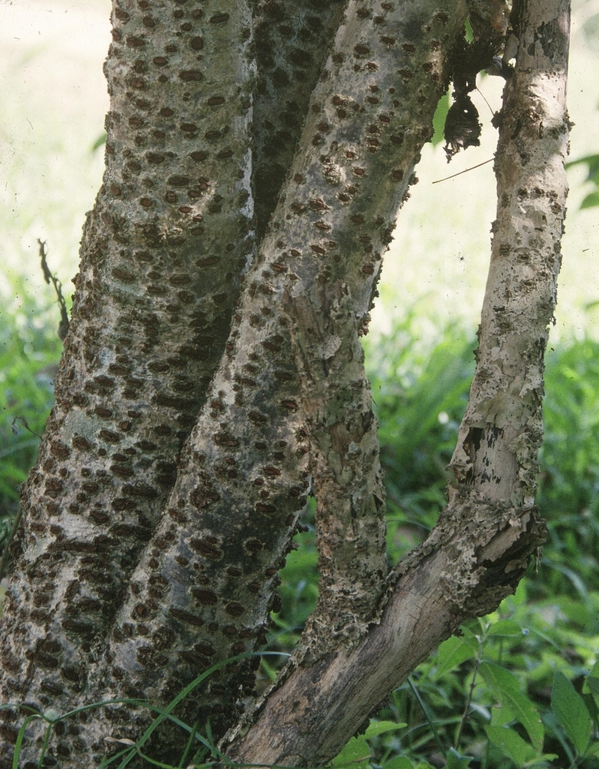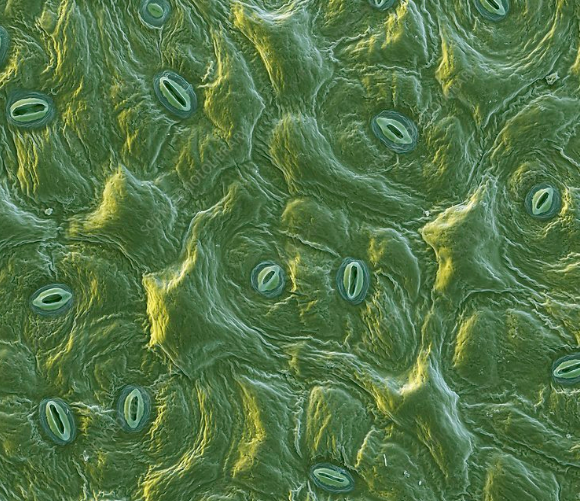What Are Lenticels?
Lenticels are one of the many raised pores in the stem of a woody plant that allows gas exchange between the atmosphere and the internal tissues. Usually, lenticels consist of large intercellular spaces in the periderm, especially in secondarily thickened organs and the bark of woody stems and roots of dicotyledonous flowering plants.
Lenticels are visible on surfaces of fruits such as mango, apple and avocado. Lenticels permit exchange of gases between the environment and the internal tissue spaces of the organs. They permit the entrance of oxygen and simultaneously the output of carbon dioxide and water vapor. In most fruits, lenticels account for up to 23%of transpiration.

What Are Stomata?

Stomata are tiny openings or pores in plant tissue that allow for gas exchange. Stomata are normally found in plant leaves but can also be found in some stems. Specialized cells referred to as guard cells surround stomata and function to open and close stomatal pores. They guard cells help plants to reduce water lose to the environment when conditions are hot and dry by ensuring that the stomata remains closed.
More importantly, stomata allow plants to take in carbon dioxide, which is necessary for photosynthesis. Terrestrial plants typically have thousand of stomata on the surfaces of their leaves. Majority of stomata are located on the underside of plant leaves reducing their exposure to heat and air current. In aquatic plants, stomata are located on the upper surface of the leaves.
There are two types of lenticels: those found in the stems, trunks and roots of woody plants and trees and those found in the skin of certain fruits such as apples.
Types Of Stomata
Stomata can be classified into different types based on the number and characteristics of the surrounding subsidiary cells. The classification includes:
- Paracytic stomata: This is whereby the subsidiary cells are arranged parallel to the stomatal pore and guard cell.
- Gramineous Stomata: This is whereby the subsidiary cells are parallel to the guard cells but the guard cells are narrow in the middle and wider at the ends.
- Diacytic Stomata: This is whereby the subsidiary cells are arranged perpendicular to each stoma.
- Anomocytic Stomata: This is whereby the stomata possess irregular shaped cells, similar to epidermal cells that surround each stoma.
- Anisocytic stomata: This is whereby an unequal number of subsidiary cells surround each stoma.
Also Read: Difference Between Lenticular, Stomatal And Cuticular Transpiration
Difference Between Stomata And Lenticels In Tabular Form
| BASIS OF COMPARISON | STOMATA | LENTICELS |
| Description | Stomata are spores found in the epidermis of leaves, stem and other organs that are used to control gas exchange. | Lenticels are lens-shaped pores present in the woody trunks or stems of plants. |
| Presence | Stomata are located in the epidermis. | Lenticels are located in peridermis. |
| Quantity of Vapour | Stomata give a large amount of water vapour to the atmosphere. | Lenticel allows a small amount of water vapour to the atmosphere. |
| Location | Stomata are mostly found on the underside of a leaf. | Lenticels are found on the stems region e.g bark of trees. |
| Photosynthesis | Stomata have guard cells which contain chloroplast hence they can photosynthesize. | Lenticels lack chloroplast hence they are unable to photosynthesize. |
| Activity | Stomata are only active during daytime. | Lenticels are active throughout day and night. |
| Function | Stomata are mainly responsible for gaseous exchange and transpiration. | Lenticels are mainly responsible for gaseous exchange. |
| Formation | Stomata are present during primary growth of plants. | Lenticels are formed after secondary growth of the plant. |
| Opening | Stomata have guard cells which regulate its opening and closing. | Lenticels do not have guard cells and hence are always opened. |
| Location | Stomata are found in the epidermis of leaves and young stems. | Lenticels are present in woody stems, twigs and fruits. |
Similarities Between Lenticels And Stomata
- Both lenticels and stomata are small pore like opening present on different parts of the plant.
- Both stomata and lenticels are involved in exchange of gases.
- They both facilitate the release of water vapour to the atmosphere.
- Both stomata and lenticels are completely composed of living cells.
- Both stomata and lenticels opens to the exterior environment.
Also Read: Difference Between Stomata And Hydathodes

Comments are closed.